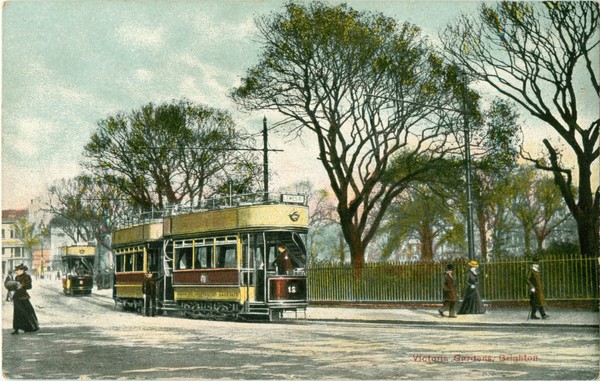John Edward Stafford

Trams at Steine Gardens, Brighton
John Edward Stafford was a prominent Brighton businessman in the 1890s and early 1900s, with a fancy goods and stationery shop called "The Bazaar" at 166 Western Road and a toy, games and oriental store two doors away at Number 168. He also had a "counting house" and warehouse in Crown Street, as well as a store in Tunbridge Wells. He was mayor of Brighton from 1899 to 1901 and also served as a local J.P.
John Edward Stafford was born at Melton Mowbray in Leicestershire in about 1841. His father, also called John Stafford, was a local pork butcher, and his mother was Ellen Goodacre. In his late teens he walked with his elder brother, Will Stafford, to London in search of employment. Will settled in Southwark, and became a successful businessman as well as an ardent supporter of the early Trade Union movement. John Edward Stafford set up home in Bayswater for some years and in 1867 married Mary Dickinson, who was also from Melton Mowbray. Together they raised at least three children. During the 1870s John Edward Stafford moved with his family to Brighton. For many years he and his family lived at 2 Crown Street off Western Road in Brighton, but in about 1900 he and Mary moved yet again - this time to Aberdeen Lodge in Wilbury Road in Hove. John died at Aberdeen Lodge on 31 December 1907, leaving an estate valued at £79,773.
Postmark evidence shows that John Stafford began publishing postcards of Brighton before the end of 1899. When divided backs were authorised, and postcard sales began to boom, he quickly introduced a variety of pleasing collotype and halftone cards.
Stafford was one of the few British publishers to issue double width or panoramic postcards. These novelties could be sent through the post for just a halfpenny provided they carried only a signature. If a message was included, a penny stamp was required. Stafford's cards are good quality collotypes showing Brighton and Hove sea front. They are labelled on the back "Stafford's Brighton and Tunbridge Wells", and claim to have been "printed at our (sic) works in Germany".
Much more numerous are some standard-sized black and white collotype postcards of Brighton published in some cases under the name "Stafford's Copyright Series". These tend to have very predictable subjects such as St Peter's Church and the Palace Pier terminus of the Volk's Railway. They too were printed in Germany, and were on sale in Brighton by 1905, if not earlier. In addition, Stafford published some coloured halftones, "printed in Bavaria", for example a view of the Dome at Brighton. These are labelled "Published & sold by Stafford's, Brighton" on the reverse. Stafford also issued coloured halftones and collotypes that were "Printed in Treves" and labelled "Stafford's, Brighton" or "Stafford's 'The Bazaar', Brighton", for example views of the "Victoria Gardens" and "The Terrace, East Brighton". T.W.S. Wiles later reprinted some of the Stafford cards under his own name.
Stafford issued only a few real photographic cards of Brighton. The best known have oval black and white photographs tinged in sepia that are raised above white surrounds edged with a facsimile black frame. A 1909 postmark has been reported.
At Tunbridge Wells, Stafford's published good quality real photographic cards with sepia photographs and narrow white borders. The printed captions are positioned centrally in the border under the photographs, and the cards are marked on the back "Staffords' Tunbridge Wells". Harold Camburn of Tunbridge Wells printed some real photographic cards for Stafford, and after the latter's death went on to publish them under his own name. Stafford (or someone who took over his business retaining the Stafford name) also arranged with the Tunbridge Wells firm of Photochrom to produce coloured halftones of the town labelled "Published by Stafford, Tunbridge Wells". These were on sale by 1913, if not earlier.
The Stafford cards published by John Stafford in the early twentieth century must not be confused with cards of the same name published by George Stafford Gouldsmith in the 1930s and later.
To directory of publishersTo gallery
Design: Lucid Design
© www.sussexpostcards.info
